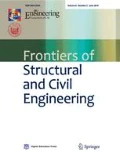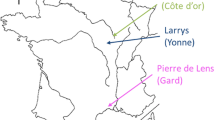Abstract
Frost heave experiments on saturated sandstone and tuff with an open crack are conducted under uniform and unidirectional freezing conditions. Frost heave of crack in sandstone with high permeability is more significant under uniform freezing condition than that under unidirectional freezing condition. However, frost heave of crack in tuff with low permeability is more significant under unidirectional freezing condition. To illustrate the reasons for this phenomenon, a numerical model on the freezing processes of saturated rock with an open crack considering the latent heat of pore water and water in crack is proposed and confirmed to be reliable. Numerical results show that a frozen shell that blocks the migration of water in crack to rock develops first in the outer part of the rock before the freezing of water in crack under uniform freezing condition. However, the migration path of water in crack to the unfrozen rock under freezing front exists under unidirectional freezing condition. The freezing process and permeability of rock together determine the migration of water in crack and lead to the different frost heave modes of crack for various permeable rocks under different freezing conditions. The frost heave modes of crack in rock with low or high permeability are similar under uniform freezing condition because water migration is blocked by a frozen shell and is irrelevant to rock permeability. For high permeability rock, the frost heave of crack will be weakened due to water migration under unidirectional freezing condition; however, the frost heave of crack would be more significant for low permeability rock because water migration is blocked under unidirectional freezing condition. Therefore, the freezing condition and rock permeability determine the frost heave of rock with crack together, and this should be concerned in cold regions engineering applications.
Similar content being viewed by others
References
Lai Y, Wu H, Wu Z, Liu S, Den X. Analytical viscoelastic solution for frost force in cold-region tunnels. Cold Regions Science and Technology, 2000, 31(3): 227–234
Gao G, Chen Q, Zhang Q, Chen G. Analytical elasto-plastic solution for stress and plastic zone of surrounding rock in cold region tunnels. Cold Regions Science and Technology, 2012, 72: 50–57
Feng Q, Jiang B, Zhang Q, Wang L. Analytical elasto-plastic solution for stress and deformation of surrounding rock in cold region tunnels. Cold Regions Science and Technology, 2014, 108: 59–68
Mufundirwa A, Fujii Y, Kodama N, Kodama J. Analysis of natural rock slope deformations under temperature variation: A case from a cool temperate region in Japan. Cold Regions Science and Technology, 2011, 65(3): 488–500
Shen B, Jung Y, Park E, Kim T. Modelling the effect of ice swelling in the rock mass around an LNG underground storage cavern using FRACOD. Geosystem Engineering, 2015, 18(4): 181–198
Nakamura D, Goto T, Ito Y, Suzuki T, Yamashita S. A basic study on frost susceptibility of rock: Differences between frost susceptibility of rock and soil. In: Proceeding of the 14th Conference on Cold Regions Engineering. Duluth, Minnesota, 2009, 89–98
Mellor M. Phase Composition of Pore Water in Cold Rocks. Research Report. Hanover, New Hampshire: US Army Cold Regions Research and Engineering Laboratory, 1970
Huang J, Xia C, Han C, Shen S. Study on the classification and evaluation method of the frost susceptibility of rock mass. In: International Symposium on Systematic Approaches to Environmental Sustainability in Transportation. Fairbanks, Alaska: American Society of Civil Engineers, 2015, 28–41
Huang S, Liu Q, Liu Y, Ye Z, Cheng A. Freezing strain model for estimating the unfrozen water content of saturated rock under low temperature. International Journal of Geomechanics, 2018, 18(2): 04017137
Lv Z, Xia C, Li Q. Experimental and numerical study on frost heave of saturated rock under uniform freezing conditions. Journal of Geophysics and Engineering, 2018, 15(2): 593–612
Akagawa S, Fukuda M. Frost heave mechanism in welded tuff. Permafrost and Periglacial Processes, 1991, 2(4): 301–309
Akagawa S, Satoh M, Kanie S, Mikami T. Effect of tensile strength on ice lens initiation temperature. In: The 13th International Conference on Cold Regions Engineering. Orono, Maine: American Society of Civil Engineers, 2006, 1–12
Nakamura D, Goto T, Suzuki T, Ito Y, Yamashita S, Kawaguchi T, Yamasaki S. Basic study on the frost heave pressure of rocks: Dependence of the location of frost heave on the strength of the rock. In: Cold Regions Engineering 2012: Sustainable Infrastructure Development in a Changing Cold Environment. Quebec City: American Society of Civil Engineers, 2012, 124–133
Laura Jane Van Alst. Laboratory experiments in cold temperature rock deformation. Dissertation for the Doctoral Degree. Eugene, Oregon: University of Oregon, 2011
Neaupane K, Yamabe T, Yoshinaka R. Simulation of a fully coupled thermo-hydro-mechanical system in freezing and thawing rock. International Journal of Rock Mechanics and Mining Sciences, 1999, 36(5): 563–580
Duca S, Alonso E, Scavia C. A permafrost test on intact gneiss rock. International Journal of Rock Mechanics and Mining Sciences, 2015, 77: 142–151
Zhou S, Zhuang X, Rabczuk T. Phase field modeling of brittle compressive-shear fractures in rock-like materials: A new driving force and a hybrid formulation. Computer Methods in Applied Mechanics and Engineering, 2019, 355: 729–752
Zhou S, Zhuang X, Rabczuk T. Phase-field modeling of fluid-driven dynamic cracking in porous media. Computer Methods in Applied Mechanics and Engineering, 2019, 350: 169–198
Zhou S, Zhuang X, Rabczuk T. A phase-field modeling approach of fracture propagation in poroelastic media. Engineering Geology, 2018, 240: 189–203
Zhou S, Zhuang X, Zhu H, Rabczuk T. Phase field modelling of crack propagation, branching and coalescence in rocks. Theoretical and Applied Fracture Mechanics, 2018, 96: 174–192
Amiri F, Millán D, Shen Y, Rabczuk T, Arroyo M. Phase-field modeling of fracture in linear thin shells. Theoretical and Applied Fracture Mechanics, 2014, 69: 102–109
Zhuang X, Cai Y, Augarde C. A meshless sub-region radial point interpolation method for accurate calculation of crack tip fields. Theoretical and Applied Fracture Mechanics, 2014, 69: 118–125
Zhou S, Rabczuk T, Zhuang X. Phase field modeling of quasi-static and dynamic crack propagation: COMSOL implementation and case studies. Advances in Engineering Software, 2018, 122: 31–49
Zhou S, Xia C. Propagation and coalescence ofquasi-static cracks in Brazilian disks: An insight from a phase field model. Acta Geotechnica, 2019, 14(4): 1195–1214
Zhou S, Zhuang X. Characterization of loading rate effects on the interactions between crack growth and inclusions in cementitious material. Computers. Materials & Continua, 2018, 57(3): 417–446
Walder J, Hallet B. A theoretical model of the fracture of rock during freezing. Geological Society of America Bulletin, 1985, 96(3): 336–346
Tharp T. Conditions for crack propagation by frost wedging. Bulletin of the Geological Society of America, 1987, 99(1): 94–102
Huang S, Liu Q, Liu Y, Kang Y, Cheng A, Ye Z. Frost heaving and frost cracking of elliptical cavities (fractures) in low-permeability rock. Engineering Geology, 2018, 234: 1–10
Davidson G, Nye J. A photoelastic study of ice pressure in rock cracks. Cold Regions Science and Technology, 1985, 11(2): 141–153
Matsuoka N. A Laboratory Simulation on Freezing Expansion of a Fractured Rock: Preliminary Data. Annual Report of the Institute of Geoscience. Tsukuba: University of Tsukuba, 1995, 21: 5–8
Arosio D, Longoni L, Mazza F, Papini M, Zanzi L. Freeze-thaw cycle and rockfall monitoring. Landslide Science and Practice. Berlin, Heidelberg: Springer, 2013, 385–390
Bost M, Pouya A. Stress generated by the freeze-thaw process in open cracks of rock walls: Empirical model for tight limestone. Bulletin of Engineering Geology and the Environment, 2017, 76(4): 1491–1505
Jia H, Leith K, Krautblatter M. Path-dependent frost-wedging experiments in fractured, low-permeability granite. Permafrost and Periglacial Processes, 2017, 28(4): 698–709
Tan X, Chen W, Tian H, Cao J. Water flow and heat transport including ice/water phase change in porous media: Numerical simulation and application. Cold Regions Science and Technology, 2011, 68(1–2): 74–84
Michalowski R, Zhu M. Frost heave modelling using porosity rate function. International Journal for Numerical and Analytical Methods in Geomechanics, 2006, 30(8): 703–722
Jung Y, Park E, Chung S, Kim H. Coupled hydro-thermal modeling of ice ring formation around a pilot LNG cavern in rock. Engineering Geology, 2011, 118(3–4): 122–133
Haynes F. Effect of temperature on the strength of snow-ice. Research report. Hanover, New Hampshire: US Army Cold Regions Research and Engineering Laboratory, 1978
Acknowledgements
This study was supported by the National Natural Science Foundation of China (Grant Nos. 51778475 and 41472248).
Author information
Authors and Affiliations
Corresponding author
Rights and permissions
About this article
Cite this article
Lv, Z., Xia, C., Wang, Y. et al. Frost heave and freezing processes of saturated rock with an open crack under different freezing conditions. Front. Struct. Civ. Eng. 14, 947–960 (2020). https://doi.org/10.1007/s11709-020-0638-z
Received:
Accepted:
Published:
Issue Date:
DOI: https://doi.org/10.1007/s11709-020-0638-z




